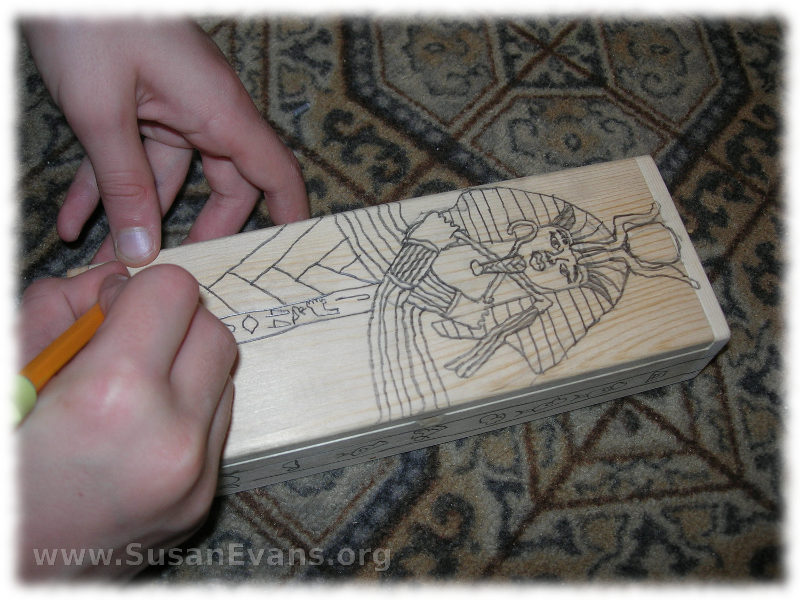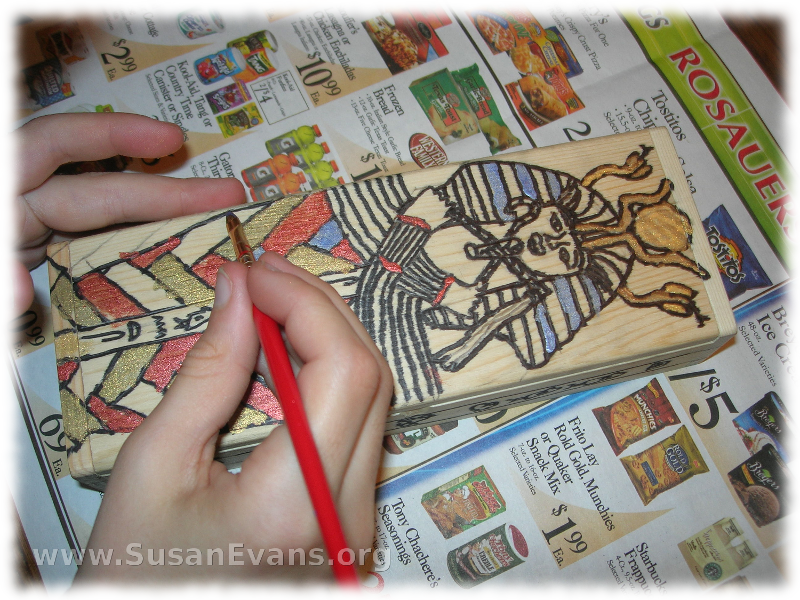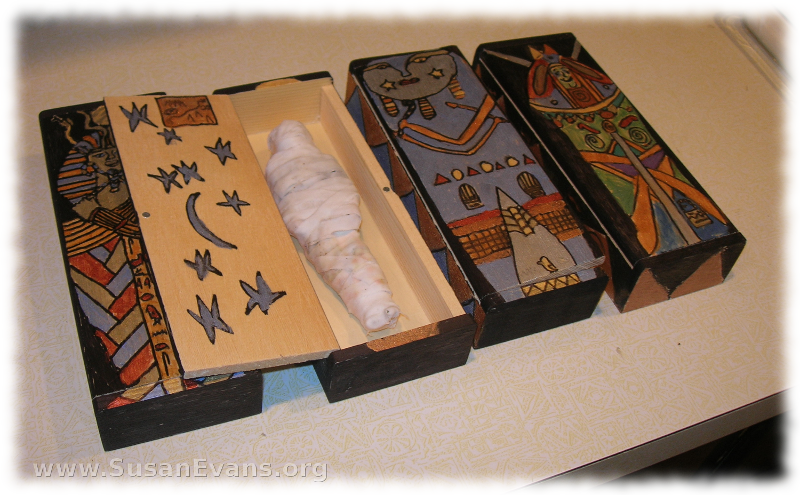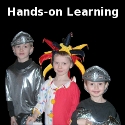Here is a video of how my children did the mummy and sarcophagus craft for their Ancient Egypt Unit Study:
Archive for the ‘Homeschooling’ Category
Mummy and Sarcophagus
Monday, October 4th, 2010Sarcophagus Craft
Friday, October 1st, 2010This sarcophagus craft is a unique idea I had as I was brainstorming how to teach my children about mummies and sarcophagi. First I grabbed a small hinged box, drew the design in pencil, outlined it, and filled it in with metallic paint. I looked for simple hinged boxes that were long enough for the mummies that we were making. I found long boxes at Hobby Lobby for $1.99. Each child drew the design with pencil first. Three of my children took less than an hour for this step. My 10-year-old took probably two hours total to draw all the details on his sarcophagus.
The next day, we outlined the pencil sketch with a black Sharpie marker. It didn’t take nearly as long as sketching the drawing. Most of my kids took about 15 minutes to outline it.
The next day, we started to paint it with metallic paints. The kids painted each day for about a week. In total, it probably took two hours to paint. My oldest son took longer, because he thought about putting contrasting colors next to each other, and he just thought more about what he was doing.
When the paint was dry, we took the Sharpie marker and outlined everything again, since the paint had gone over it, and it looked slightly sloppy. Any bare wood was colored in by the Sharpie marker.
My 5-year-old daughter would happily paint for 15 minutes each day, and then she would be fatigued, because there was a lot of detail on her sarcophagus. (She drew it free hand by looking at a coloring book page, the same one she used for her papyrus picture.) When she was more than halfway finished painting her box, she said, “I’m done with my sarcophagus!” I thought about it for a minute, then I modified the project. I gave her metallic Sharpie markers to finish the sarcophagus. She was very happy with this alteration, because she could control the marker much better than the paintbrush. Older students should use the metallic paint, because it looks better than the metallic markers. But for a younger child, this is an easy way to modify the project in order to complete it.
Mummy Dolls
Wednesday, September 29th, 2010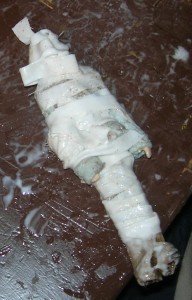 For our study of Ancient Egypt, we made some mummy dolls. This is how we did it.
For our study of Ancient Egypt, we made some mummy dolls. This is how we did it.
My daughter’s doll house dolls were matted, so I upgraded her dolls. I decided to turn the old dolls into mummies. First we washed the doll with water and spices. We used cinnamon to represent the spices, and after doing research, I discovered that cinnamon was one of the spices used on mummies anyway. Second, we immersed the mummy in salt and spices. Third, we washed it with oil and spices. Lastly, we put on strips of linen. Actually, the strips were from an old bed sheet, and instead of sticky resin, we used white school glue mixed with little water.
 The gluey mixture was very messy. If I had it to do over again, I would put wax paper under the whole project. (I didn’t want to put newspaper under it, because obviously the mummy would stick to the newspaper. But scrubbing the glue off the table wasn’t fun.)
The gluey mixture was very messy. If I had it to do over again, I would put wax paper under the whole project. (I didn’t want to put newspaper under it, because obviously the mummy would stick to the newspaper. But scrubbing the glue off the table wasn’t fun.)
It took two days for the mummies to dry. That is, except for Bryan’s. His mummy had so much oil on it that it seemed wet from the inside. Bryan decided to submerge it into salt, so that the salt would extract the moisture. (He learned that from our reading about mummies.) Sure enough, it worked. After only two days of sitting in the salt, the mummy was as dry as the Egyptian sand.
The Myth of Losing Math Over the Summer
Monday, September 27th, 2010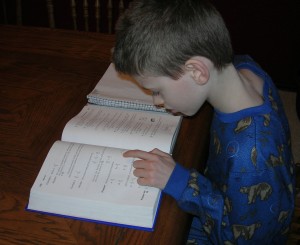 This past summer was the first time I did not do math with my children for three months. I have always homeschooled three months on, one month off, to have three huge breaks during the year, with no break being so long that the kids were bored half out of their minds. Well, this summer I had a lot to do for my business, so I decided to take a real summer break. Of course, we ended up doing tons of homeschooling anyways by accident because we can’t help learning all the time. But we did no math whatsoever.
This past summer was the first time I did not do math with my children for three months. I have always homeschooled three months on, one month off, to have three huge breaks during the year, with no break being so long that the kids were bored half out of their minds. Well, this summer I had a lot to do for my business, so I decided to take a real summer break. Of course, we ended up doing tons of homeschooling anyways by accident because we can’t help learning all the time. But we did no math whatsoever.
After three weeks of school, I realize that it’s a complete farce that kids lose their math over the summer. Sure, if the kids never learned their multiplication tables for real, they might not remember them. But they never really learned them in the first place. Timed drills can help your child to really learn their math facts until they are second nature. Anyway, math programs assume that you’ve taken the summer off, and they make the first few weeks easy-peasy on purpose to review what was done the previous year.
Just look back on your own childhood memories. Didn’t some of your best childhood memories take place on the long and lazy summer days? Weren’t you all refreshed to start the new school year in September because you were happy to get into the swing of things after so long a break? Should I never give my children the gift of a real summer holiday, where they can play and run and fill their days with their own ideas of what they would like to pursue?
It was my children’s first summer break ever this year, and I’m glad we did it. They didn’t lose their math. They’re getting A’s. “Mom, this math is so easy,” they say. So now I know that losing math over the summer is a complete myth, and I now have the freedom to take a summer break if that’s what we want to do. Hurray for summer!


